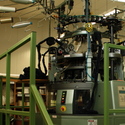The Kiwi Innovation Network (KiwiNet) is a network of public research organisations who collaborate to commercialise science to grow the New Zealand economy. Commercialising science can include innovation to add value to existing products and transforming science research and discoveries into products and services.
The annual KiwiNet Research Commercialisation Awards celebrate the entrepreneurial spirit of those who are commercialising publicly funded research. There are five awards including a supreme award. 2018 was the first time voting for the supreme winner was opened up to the general public, and this resulted in another first where the overall winner was not drawn from the category winners.
BNZ Supreme Award 2018
A finalist in the Norman Barry Foundation Breakthrough Innovator Award, molecular biologist1 Dr Andrew Kralicek of Plant & Food Research was awarded the BNZ Supreme Award in 2018.
Andrew and his molecular sensing team worked to harness insects’ sense of smell in order to develop a biosensor that could be used in commercial applications.
Of the five senses, Andrew recognised that smell remained unexploited in technological applications. He also knew that insects are infinitely superior to humans at sensing smell and can recognise different volatile2 compounds in miniscule concentration.
Think of your smartphone: there is touch, hearing and vision, but no taste or smell – we are hoping one day insect smell receptors will be in your smartphone turning it into an artificial nose.
Dr Andrew Kralicek
The key to Andrew’s work was recreating insect olfactory3 sensilla in the lab and developing a way to couple these with the surface of different sensors. Achieving this was the technological breakthrough that provided the proof of concept that has enabled Andrew to develop relationships with companies and manufacturers in order to commercialise the technology.
The possible applications for this technology are broad and could include disease4 and medical diagnosis5, indicating fruit ripeness, identifying the presence of pathogens6 and biosecurity7 threats.
Andrew is working with Better Border Biosecurity to develop a prototype8 handheld tool for biosecurity officers to identify insects.
View the KiwiNet video: Dr Andrew Kralicek – Harnessing insects’ amazing powers of smell to revolutionise commercial sensing.
Curious about how insects smell when they don’t have a ‘nose’? Check out Insect antennae.
Norman Barry Foundation Breakthrough Innovator Award 2018
In 2018, Dr Vlatko Materić from Hot Lime Labs picked up the breakthrough innovation award for his development of a sustainable9 technology to increase glasshouse yields while reducing their carbon footprint10.
To grow, plants need water, light and carbon dioxide11 (CO2) for photosynthesis. Vegetable growers know this, and one way they work to increase yields is to pump CO2 into glasshouses. However, this was often something only large-scale growers could access, and it relied on the fossil fuel12 natural gas, a non-renewable energy source that contributes to greenhouse gases.
At Callaghan Innovation, Vlatko developed a technology that recovers the CO2 from the burning of organic waste material and then releases this ‘clean’ CO2 into the glasshouse.
Hot Lime Labs was set up to commercialise the technology and has attracted finance from private investors to install the first plant. The potential for this technology is estimated at over $800m a year, and Hot Lime Labs already has a number of growers lined up for commercial trials.
View the KiwiNet video: Dr Vlatko Materić – Increasing crop yields with sustainable CO2.
Learn more about CO2 and climate change13 in the articles Carbon dioxide and climate and the Greenhouse effect, and take a closer look at the carbon dioxide cycle.
Baldwins Researcher Entrepreneur Award
Associate Professor Taehyun Rhee (TJ), director of the Victoria Computer Graphics Lab, was recognised for his innovative research to solve real-world problems with virtual and augmented reality14 and his work to improve the commercialisation15 of it. He was awarded the 2018 Baldwins Researcher Entrepreneur Award.
TJ is also the deputy director and research director of the Computational Media Innovation Centre at Victoria University of Wellington. TJ played an important role in setting up the centre, which works to support potential start-ups and develop links with international gaming and anime companies and institutes. He also heads the Victoria Computer Graphics Lab and helped to establish the Victoria Computer Graphics Programme in collaboration16 with Weta Digital.
In early 2018, TJ set up DreamFlux, a company to commercialise the MR360 Toolkit, a technology developed at Victoria University. The MR360 toolkit supports augmented reality and mixed reality17 (AR/MR) technologies to better combine the real and virtual – for example, the integration of 3D objects into 360° video.
Examples of augmented reality are Pokémon GO and the filters on Snapchat. Mixed reality uses augmented reality and virtual reality18 to allow real-world and digital objects to interact. To view examples of mixed reality, visit the DreamFlux website.
View the KiwiNet video: Associate Professor Taehyun Rhee – Taking New Zealand’s VR and AR tech to the world.
MinterEllisonRuddWatts Research & Business Partnership Award 2018
The MinterEllisonRuddWatts Research & Business Partnership Award recognises relationships between research organisations and business that deliver significant commercial value for New Zealand.
The Square Kilometre Array (SKA) is building two large radio telescope arrays in South Africa and Australia. It is anticipated that the large amounts of data19 these will be capable of collecting will aid scientists to answer questions such as how do galaxies evolve?
The NZ SKA Alliance is made up of AUT, the University of Auckland, Massey University and a number of companies. Together, they undertake research and design for the computing that will be needed to make the SKA a reality.
AUT computer scientist Dr Andrew Ensor is also the New Zealand lead for the SKA project and says the biggest impacts for New Zealand will not be in space, but in the ICT20 field.
The SKA is the biggest ICT project in the world, encompassing big data science21, high-performance computing and software engineering. Radio astronomy is thus not the major benefactor of New Zealand’s SKA investment – it’s largely the ICT sector and ultimately, through its innovation22, the wider economy: expertise23 development, growth and jobs.
Dr Andrew Ensor
View the KiwiNet video: Square Kilometre Array Radio Telescope – The world’s Mega-Science Partnership of the next decade.
PwC Commercial Deal Award 2018
Plant & Food Research was awarded the PwC Commercial Deal Award for their commercialisation of Amarasate, a plant-based extract24 for reducing food cravings. The extract is seen as having massive economic potential in the international weight management market.
Calocurb is the trade-marked supplement that contains the Amarasate extract. It has been licensed by Lifestream International, a New Zealand company that has released it into the lucrative American market.
The Amarasate extract is from New Zealand-grown hops. It releases bitter extracts in the duodenum25. These bitter extracts use the body’s evolutionary response to bitter compounds – a response that triggers taste sensors in the gut that release satiety26 peptides that in turn send a ‘stop eating’ signal in the brain.
View the KiwiNet video: Amarasate to Help Manage Food Cravings –100% plant-based weight management extract.
Learn more about the underlying science of this weight management supplement and the research of Plant & Food scientists to develop it in the articles Hormonal control of digestion, Satiety research and Foods to keep us feeling full.
Nature of science
Science is often developed in response to a problem. The exciting part of that is in the process of finding solutions – new discoveries are made that inform many other developments.
Activity idea
The KiwiNet Awards celebrate successful innovation in New Zealand. To explore the concept of innovation further in a New Zealand context, students could use this activity on unpacking innovation.
Related Content
Take a look at some of the previous winners of the KiwiNet Awards in 2013, 2014, 2015, 2016 and 2017.
Useful links
Visit the Kiwinet Awards website.
Hear more about Dr Andrew Kralicek’s work in the Scigest podcast from Plant & Food Research and in this news article: Could our smartphones soon be able to smell?
Listen to this RadioNZ news item for a simple explanation of the Hot Lime Labs technology developed by Dr Vlatko Materić: Woodchips used to pump CO2 into greenhouses. Visit the Hot Lime Labs website here.
Read more about the work of the Computational Media Innovation Centre here.
For more information on the Square Kilometre Array, go to their website.
Read this Stuff news article to learn more about the development and commercialisation of Amarasate. Visit the Calocurb website to see how the product is being marketed.
- molecular biologist: A person who studies cells at the molecular level in order to understand the interactions between components like DNA, RNA and proteins.
- volatile: Easily evaporates or turns into a gas; used in everyday language to mean something that changes quickly.
- olfactory: Relating to the sense of smell.
- diseases: 1. An abnormal condition of an organism that impairs bodily functions. 2. In plants, an abnormal condition that interferes with vital physiological processes.
- diagnosis: The identification of disease through the examination of the symptoms.
- pathogen: A disease-causing organism.
- biosecurity: The process of preventing, detecting and controlling unwanted pests and diseases.
- prototype: A trial working model or preliminary version of something. Sometimes a prototype might be smaller than the final version of an engineered object, so that the engineers can check if the design works before committing themselves to large-scale commercial production.
- sustainable: A way of using natural products so they are available for future generations.
- carbon footprint: The total amount of greenhouse gas emissions caused by a defined population such as an organisation, product, activity or system.
- carbon dioxide: CO2 is a colourless, odourless, incombustible gas. It is a product of cellular respiration and combustion and is an essential component in photosynthesis.
- fossil fuel: Materials such as coal, oil and natural gas formed from the fossilised remains of plants that lived many millions of years ago. Often burned as fuel – although this releases large amounts of CO2, which contributes to global warming. Fossil fuels are also not renewable – there is a limited amount.
- climate change: The large-scale, long-term increase in the Earth’s average temperatures, with associated changes in weather patterns. There is significant scientific evidence that warming is due to increased quantities of greenhouse gases in the atmosphere, with most of the rise due to human activity.
- augmented reality: A technology that adds digital elements to a live view of the real world.
- commercialisation: To take an idea and turn it into a business in order to make money from it.
- collaboration: Working together with a common purpose.
- mixed reality: A technology that allows real-world and digital objects to interact. It uses both augmented reality and virtual reality.
- virtual reality: A digitally generated environment that a person can interact with using specialised equipment such as a virtual reality headset.
- data: The unprocessed information we analyse to gain knowledge.
- ICT: Information and communication technologies.
- data science: A multi-disciplinary field that uses scientific methods and processes and algorithms to gain knowledge and insights from data.
- Innovation: The development of a new process or product that is then used by others.
- expertise: Having excellent knowledge or skills in a particular area.
- extract: (Noun) A chemical preparation containing the active ingredient in concentrated form. (Verb) To separate out or remove.
- duodenum: The first section of the human small intestine. It is about 25–30 cm in length and plays a vital role in the digestion of food passed into it from the stomach.
- satiety: The lack of appetite or hunger for a period of time following a meal.







